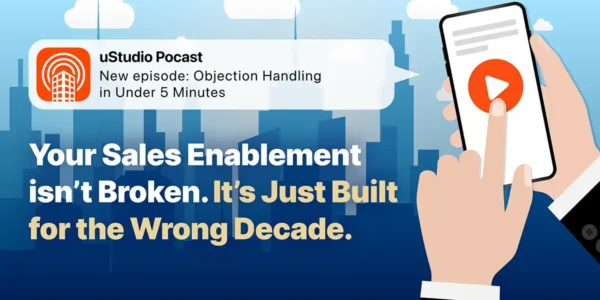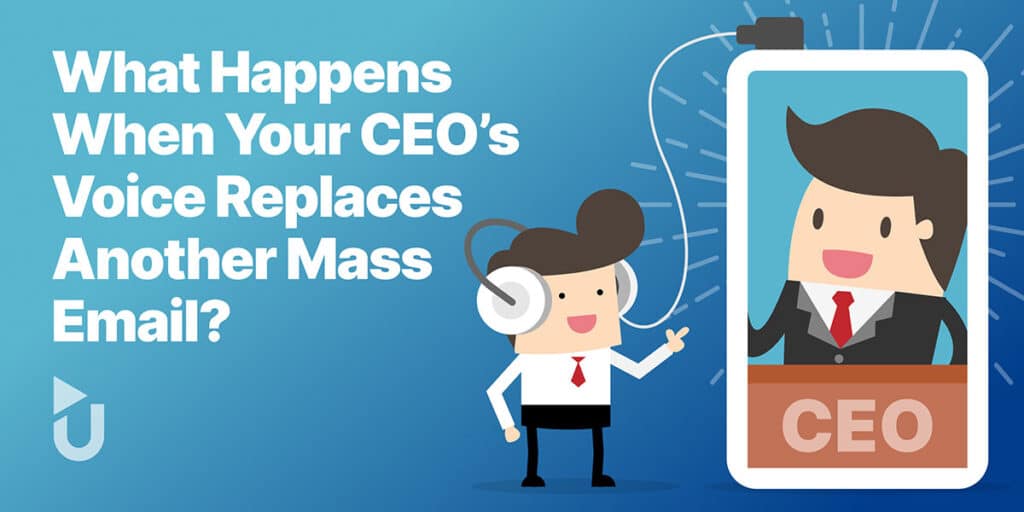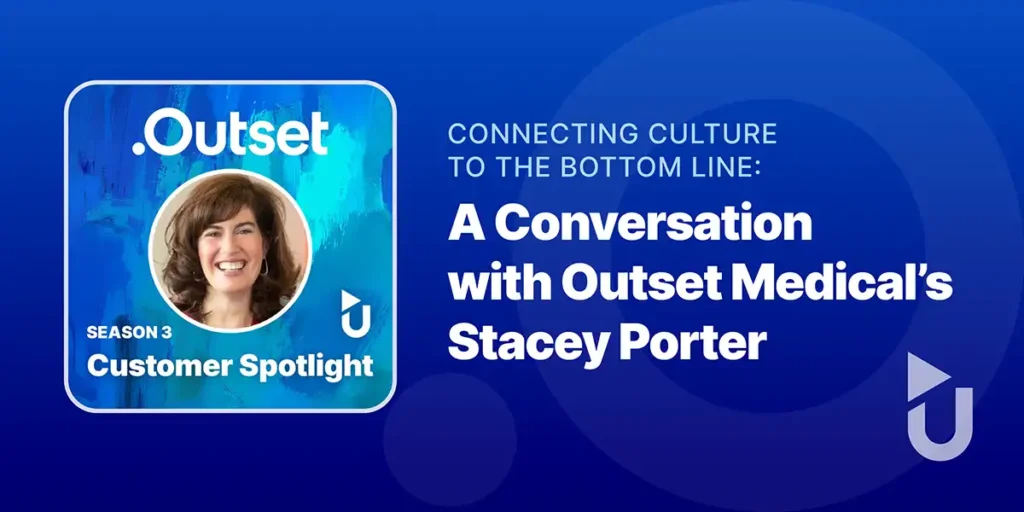Your Sales Enablement isn’t Broken. It’s Just Built for the Wrong Decade.
Michael Wright - VP of Sales at uStudio | Blog, Podcasting, Sales

The TL;DR
- Sales enablement content isn’t landing. Not because it’s wrong, but because it’s delivered in outdated formats.
- Reps are mobile, distracted, and time-starved; static portals and LMS modules don’t fit their workflow.
- Teams are seeing increased engagement by shifting enablement content to secure, short-form audio.
- Modern, push-based formats meet reps where they are. They turn content into habit, not homework.
The Sales Enablement Gap No One Talks About
Sales enablement leaders have no shortage of content.
Playbooks. Product one-pagers. Certification modules. LMS trainings.
The real challenge? Getting reps to engage with it and actually apply it in the field.
They skip the trainings. They skim the decks. They promise to revisit that 27-slide overview… but never do.
Not because they don’t care.
Because they’re overloaded, mobile, and out of time.
The average day of a field rep is filled with context-switching. Zoom calls, CRM updates, inbox chaos, Slack pings, and pressure to hit quota. There’s no space left for an outdated learning model that asks reps to sit still, log in, and focus on a dense portal of documents.
And yet that’s still how most enablement is delivered.
It’s not a content quality issue. It’s a context delivery issue.
The Format, Not the Content, Is the Bottleneck
Most enablement strategies are still rooted in old habits:
Build a deck. Record a webinar. Upload it to the LMS. Email the link. Hope they engage.
But most sales reps don't work, or learn, like that.
They’re not at a desk with 45 minutes of quiet time. They’re in motion.
They need knowledge that’s immediate, digestible, and friction-free.
If engaging with enablement content requires slowing down, logging in, or digging through a portal, it gets skipped, no matter how valuable the content is.
And that’s the bottleneck: not the message, but the mode of delivery.
Until enablement teams address the format problem, they’ll keep losing the engagement battle, no matter how good the content is.
What Reps Actually Need
What reps need isn’t more content. It’s content that moves with them.
Modern sales reps need enablement that:
- Fits the flow of their day: in the car, between meetings, at the gym
- Works on the go: mobile-first, offline-capable, easy to resume
- Feels like the media they already consume: not an outdated portal with static slides
- Supports habit-building: through short, high-frequency bursts of reinforcement
- Keeps pace with change: quick updates as messaging, competitors, and products evolve
Reps don’t just want answers, they want access.
And the more seamless that access feels, the more likely they are to tune in and apply what they’ve learned.
A Real-World Pattern: When Reps Actually Tune In
We’ve seen teams use private audio to solve real gaps in their enablement flow.
One global SaaS company that supports the automotive, insurance, and repair industries started using internal podcasting to tackle a familiar problem: reps weren’t retaining the information packed into dense onboarding materials and product documents.
So they changed the format.
Instead of sending PDFs or pushing reps to rewatch webinars, they launched a series of short, mobile-first audio episodes, focused on customer stories, competitive positioning, value selling tactics, and product updates. Delivered securely through a private podcast feed, the content was easy to access on the go.
The results? The content was actually being consumed with reps listening to the podcasts in the car, on planes, and in the field. And with that adoption, the sales managers now had a consistent mechanism to reinforce messaging, positioning, sharing wins and product news.
- Onboarding time dropped from 12 weeks to just 4–6 weeks
- Reps started speaking to customers with confidence, earlier
- ASP increased, with reps more consistently asking for full list price
- Time spent re-explaining product features in 1:1s was significantly reduced
No dashboards. No LMS login. Just a modern format that aligned with how reps actually consume information today.
The content didn’t change.
The delivery did.
This Isn’t About Creating More Content
It’s not about volume.
It’s about velocity, accessibility, and repeatability.
Enablement leaders are sitting on a goldmine of institutional knowledge, product positioning, win stories, objection handling, competitive landmines, and more. But most of it is trapped in formats reps don’t use.
Turning that knowledge into secure audio updates removes the friction and opens a new lane of influence without requiring teams to produce more material.
Instead of re-recording another 45-minute training, teams can break that insight into 5-minute micro-lessons that reps actually finish.
The content already exists. It just needs to move.
The New Enablement Muscle: Passive, Push-Based Learning
The smartest enablement teams aren’t ditching their LMS.
They’re building a second layer. One that delivers content passively, contextually, and at the exact moment reps are most open to learning.
This layer isn’t a podcast in the traditional sense.
It’s a secure, push-based communication channel that feels like a media experience, but functions like a training multiplier. They just press play.
And when they’re able to consume content without breaking stride, they remember it, reference it, and reuse it.
This is the new enablement muscle:
- Always-on content that meets reps where they are
- No screen required
- Built for velocity, not volume
- Increases consistency without increasing effort
Because when training becomes part of the workflow, enablement stops being a hurdle and starts becoming a habit.
FAQs:
Q: What’s the biggest reason reps don’t complete training content?
The format often requires too much time and focus. Static documents, slide decks, and LMS modules don’t fit the day-to-day reality of a rep in motion.
Q: How can private podcasting help with sales enablement?
It lets enablement leaders deliver short, secure audio updates that reps can consume on the go. It’s passive-first learning. Ideal for drive-time, downtime, or pre-call prep.
Q: Does this replace the LMS or just complement it?
It complements it. Think of podcasting as a low-friction layer that increases content reach, recall, and consistency. No login required. No extra clicks.
Q: Is this something reps will actually use?
Yes. Especially when the content is relevant, brief, and easy to access. We’ve seen consistent engagement in podcast-based sales enablement programs when reps are given content in formats they already use in their personal lives.
Q: Can internal podcasting actually speed up onboarding or increase revenue?
Yes. One team saw onboarding time cut in half—from 12 weeks to 4–6—while also boosting rep confidence in value selling and raising average selling price.

Michael Wright is a seasoned sales and customer success leader with over 15 years of experience in sales, account management, and client success. He has held progressive leadership roles at companies such as SpareFoot (2011–2017) and Rollick (2017–2022), where he served as VP and Director of Sales and Account Management. Currently, he is the VP of Sales and Customer Success at uStudio and an Executive Member at Pavilion.
Michael began his career as a Surgical Attendant at St. Mary’s Hospital and later transitioned into sales and account management roles at IT Convergence, Precision Tune Auto Care, and others. He holds a B.A. from the University of Virginia and completed a Post Baccalaureate Pre-Medical Program at UC Berkeley Extension.


